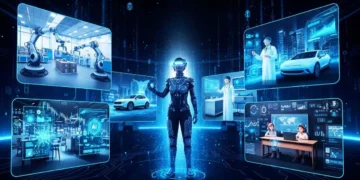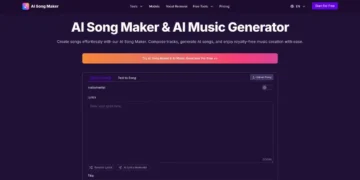What if the most powerful technology in your life was the one you never noticed? Think about it: when was the last time you actively thought about the electricity powering your home or the Wi-Fi connecting your devices? These technologies became truly transformative when they faded into the background, becoming invisible enablers rather than constant distractions. Invisible AI is following exactly the same path, evolving from a novelty we interact with to an intelligence that surrounds and assists us without demanding our attention.
This isn’t about hiding technology from users; it’s about creating such seamless integration that using artificial intelligence feels as natural as breathing. The most advanced AI systems no longer require you to open a special app or learn complex commands. Instead, they anticipate your needs, optimize your environment, and enhance your capabilities quietly working in the background. From Ambient Invisible Intelligence that adjusts your workspace lighting and temperature to manufacturing systems that monitor production quality autonomously, the future of AI is disappearing from view even as its impact grows exponentially.
But how did we get here? And what does this mean for businesses, developers, and everyday users? More importantly, how can you leverage this shift toward invisible technology? In this comprehensive guide, we’ll explore the revolution of Invisible AI, its practical applications across industries, and how you can position yourself at the forefront of this transformative trend.
What Exactly Is Invisible AI? Beyond the Hype
The Evolution from Visible to Invisible Technology
Today, most AI systems are still “visible” – we consciously interact with voice assistants, open chatbot interfaces, and manually request AI-generated reports. But the future belongs to invisible AI – intelligence that fades into the background, quietly optimizing processes, nudging behaviors, and orchestrating systems without drawing attention to itself . AI won’t feel like a separate tool; it will feel like the environment itself is intelligent.
This shift mirrors historical technological transformations. During the second industrial revolution, factories initially simply replaced steam engines with electric motors while keeping the same tangled web of belts and pulleys. True transformation came only when engineers redesigned entire factory layouts to take full advantage of electric power, integrating motors directly into individual machines . Invisible AI represents a similar fundamental rethinking of how intelligence integrates into our systems and workflows.
Defining Ambient Invisible Intelligence
Ambient Invisible Intelligence refers to the seamless integration of artificial intelligence and smart technologies into everyday environments, functioning autonomously in the background without direct human intervention . Unlike traditional AI that requires explicit user interaction, Ambient Invisible Intelligence operates subtly, analyzing data, predicting needs, and delivering personalized experiences without disrupting daily activities .
Imagine walking into your workspace: lights adjust automatically based on your preferences, your meeting summary is already written and waiting, the right applications are preloaded with the documents you’ll need, and AI has flagged the three critical decisions requiring your attention – all without you asking for any of it . This is the promise of Ambient Invisible Intelligence – creating environments that anticipate and respond to your needs proactively.
How Invisible AI Works: The Technical Foundation
The Core Components of Invisible AI Systems
Behind every effective Invisible AI system lies a sophisticated technical foundation that enables its seamless operation:
Pervasive Sensor/IoT Networks: Ambient invisible intelligence relies on large-scale networks of small, low-cost sensors and tags (RFID, beacons, cameras, wearables, etc.) embedded throughout homes, offices, factories and public spaces . These sensors continuously collect data about the environment, occupants, and processes without requiring human intervention.
Context Awareness: Advanced systems understand and adapt to their environment by fusing data on user behavior, location, time of day, and environmental conditions like light and temperature . This allows them to infer what users need, often before users themselves are consciously aware of those needs.
Edge AI and Fog Computing: Rather than relying solely on cloud-based servers, Invisible AI often processes computations closer to the source of data generation . This approach reduces latency, enhances security, and improves real-time decision-making – crucial factors for applications where delays are unacceptable.
AI-Powered Management Platforms: These platforms analyze sensor data, automate environmental controls, and predict potential issues such as equipment failures . They serve as the central nervous system that coordinates various intelligent components into a cohesive, responsive whole.
The Role of Advanced Algorithms and Machine Learning
At the heart of any Invisible AI system are sophisticated algorithms that transform raw data into intelligent action. Machine learning models identify patterns in user behavior, predict future needs, and continuously optimize system performance. The true magic happens when these algorithms become so refined that their operations feel instinctive – adjusting your environment not based on rigid rules, but on a deep understanding of your preferences and habits.
Key Characteristics of Effective Invisible AI Systems
What separates truly transformative Invisible AI implementations from mere gadgetry? The most effective systems share several defining characteristics:
Unobtrusive, Background Operation: The “invisible” aspect means these technologies run quietly behind the scenes . Unlike traditional smart devices that wait for a command, ambient systems operate without requiring user interaction.
Proactive & Anticipatory: Beyond just responding to explicit commands, Ambient Invisible Intelligence predicts needs and takes action ahead of time . For instance, a smart car might suggest an alternate route based on traffic patterns and your calendar appointments.
Self-Optimizing: The best systems continuously improve their performance based on feedback loops, learning which actions produce the best outcomes in different contexts.
Cross-Platform Integration: Invisible AI thrives not as a standalone product, but through integration across ecosystems . It connects your car, home, office, and devices into a cohesive intelligent environment.
Personalized Yet Unobtrusive: These systems use artificial intelligence and machine learning to learn user preferences and tailor experiences over time , but they do so without constantly reminding you they’re collecting data.
The Evolution From Active to Passive AI
The journey toward truly Invisible AI has followed a clear progression:
Explicit Command Systems (Early AI): Users give specific instructions to AI systems through structured interfaces
Natural Language Interfaces (Current Mainstream): Users interact with AI through conversational language, as with voice assistants
Context-Aware Systems (Emerging): AI understands context and user patterns to provide proactive suggestions
Ambient Intelligence (Cutting-edge): AI is embedded throughout environments, operating continuously without direct commands
This evolution represents a fundamental shift in the human-AI relationship, moving from tools we operate to partners we collaborate with—often without even realizing it. As one industry observer notes, “Technology is becoming increasingly intuitive, merging effortlessly into everyday life without requiring continuous user engagement” .
The Core Technologies Powering Seamless Intelligent Integration
Artificial Intelligence and Machine Learning
At the heart of any Invisible AI system are sophisticated algorithms capable of learning from data, recognizing patterns, and making predictions or decisions with minimal human intervention. The quality of AI integration directly determines how effectively these systems can understand context and anticipate needs.
Machine learning models, particularly deep learning networks, enable systems to continuously improve their performance based on new data. This allows for increasingly accurate predictions about everything from manufacturing equipment failures to individual user preferences in smart homes. The most advanced systems employ multiple AI approaches—including computer vision, natural language processing, and predictive analytics—to create comprehensive understanding of complex environments.
IoT and Smart Sensors: The Sensory Nervous System
The proliferation of Internet of Things (IoT) devices and smart sensors has been a crucial enabler for Invisible AI. These connected devices serve as the sensory organs of intelligent systems, collecting real-time data on everything from temperature and motion to machine performance and human presence.
In manufacturing environments, companies like Invisible AI deploy “synchronized depth-sensing cameras” and other sensors that “analyze human motion and objects on the factory floor in real time to help your team operate more efficiently” . This visual intelligence provides the raw data that AI systems transform into actionable insights.
Edge Computing: Intelligence at the Source
For Invisible AI to be truly seamless, it often can’t rely solely on cloud-based processing. Edge computing brings computational power closer to where data is generated, enabling real-time analysis and response without the latency of cloud communication.
This approach is particularly valuable in applications where milliseconds matter, such as autonomous vehicles or industrial safety systems. The benefits are substantial: “Edge computing handles data near its origin, which minimizes delays and allows for instantaneous reactions” . This distributed computing model also enhances privacy and security by processing sensitive data locally rather than transmitting it to central servers.
Natural Language Processing: The Bridge to Human Communication
While Invisible AI typically minimizes direct interaction, advanced natural language processing (NLP) capabilities remain essential for systems that do require occasional human input. NLP enables more intuitive communication when needed, allowing users to interact with systems using natural language rather than complex commands or interfaces.
Real-World Applications: Where Invisible AI Is Already Transforming Industries
Smart Homes and Living Spaces
Ambient Invisible Intelligence is revolutionizing residential environments by creating intuitive and responsive smart home ecosystems . AI-driven thermostats, intelligent security systems, and voice-activated assistants work in tandem to enhance comfort, security, and energy efficiency. For example, systems like Amazon Alexa and Google Nest use predictive analytics to optimize lighting, heating, and security settings based on user behavior patterns .
Have you ever experienced walking into a room where the lights turn on automatically, the temperature adjusts to your preference, and your favorite music begins playing softly? That’s Invisible AI in action – creating environments that feel magically attuned to your needs because the technology has disappeared into the background.
Healthcare and Medical Diagnostics
The healthcare sector benefits significantly from Ambient Invisible Intelligence through real-time patient monitoring, early disease detection, and personalized treatment plans . Wearable devices such as Fitbit and Apple Watch track vital signs and alert medical professionals in case of abnormalities . More advanced applications include hospital rooms that monitor patient movement to prevent falls and AI-driven diagnostics that analyze medical images to flag potential issues.
Consider the profound implications for elderly care: Ambient Invisible Intelligence can enable aging adults to maintain independence longer, with systems that detect unusual patterns (like extended inactivity) and alert caregivers while respecting privacy more than traditional cameras would.
Manufacturing and Industrial Automation
Factories and industrial facilities are implementing Ambient Invisible Intelligence to optimize production lines, monitor equipment health, and enhance worker safety . Companies like Invisible AI (the company) have developed vision execution systems that analyze human motion and objects on the factory floor in real-time to help teams operate more efficiently .
Toyota Motor North America, for instance, has partnered with Invisible AI to “build the manufacturing processes of the future” . Their systems provide benefits like:
Proactive ergonomics monitoring to prevent workplace injuries
AI-powered root-cause analysis that reduces investigation time from hours to minutes
Real-time production optimization by identifying bottlenecks and cycle time anomalies
One automotive manufacturer reported: “I used to spend 3-4 hours a day root-causing all the problems on the line. Now, I just type in the serial number and find the root-cause in minutes” .
Workplace Efficiency and Digital Assistants
Corporate environments are integrating AI-driven digital assistants and automation tools to enhance productivity and streamline workflows . These include AI-powered scheduling systems, real-time transcription services, and smart meeting rooms that enable seamless collaboration .
The most effective workplace Invisible AI doesn’t replace existing tools but enhances them. Imagine drafting an email and having AI subtly prompt you with relevant information from recent projects, or joining a video conference where the system automatically generates and distributes meeting notes – all without you having to activate these features manually.
Retail and Customer Experience
Retailers harness AI-powered ambient intelligence to create personalized shopping experiences and streamline operations . Facial recognition technology, smart shelves, and automated checkout systems enhance convenience and efficiency while remaining largely invisible to customers .
Companies like Amazon and Walmart use AI-driven recommendation engines to offer personalized product suggestions . More advanced implementations include stores where you can simply walk out with your items, with sensors and computer vision systems automatically detecting what you’ve taken and charging your account accordingly.
Smart Homes and Buildings
Our living and working spaces are becoming increasingly intelligent, with Invisible AI systems managing everything from climate control to energy usage based on occupancy patterns and individual preferences. These systems learn from our behaviors over time, automatically adjusting environments to optimize comfort and efficiency while minimizing resource consumption.
The true mark of success in this domain is when residents and occupants rarely need to adjust thermostats or lighting controls manually—the systems simply maintain ideal conditions through continuous, unobtrusive monitoring and adjustment. As one analysis notes, this technology “functions discreetly behind the scenes, addressing user demands without requiring direct engagement” .
Smart Cities and Transportation
Smart cities leverage Ambient Invisible Intelligence to optimize traffic management, reduce congestion, and enhance public safety . Autonomous vehicles, such as Tesla’s self-driving cars, use AI-powered perception systems to navigate urban landscapes efficiently . Additionally, AI-driven traffic control systems analyze real-time data to optimize signal timings, improving road safety and reducing emissions .
The Business Advantages: Why Invest in Seamless AI Integration?
Enhanced Operational Efficiency
The efficiency gains from well-implemented Invisible AI systems can be substantial. By automating monitoring, analysis, and optimization tasks that would otherwise require human attention, organizations can achieve more with the same resources while often improving outcomes.
In manufacturing settings, companies report being able to “react quickly to line slowdowns by looking at the highest cycle time on our Invisible AI dashboard and call the supervisor in minutes to address any issue” . This responsive efficiency would be impossible with traditional manual monitoring approaches.
Improved Safety and Risk Mitigation
Invisible AI systems excel at continuous, vigilant monitoring in ways humans simply cannot sustain. In industrial environments, computer vision can identify potential safety hazards in real-time, from workers without proper protective equipment to unsafe proximity to machinery.
This proactive safety approach represents a significant advancement over traditional reactive models. As one technology provider notes, their systems help “EHS teams proactively protect the workforce” through features like “ergonomics monitor, forklift tracker, and incident root-cause analysis” .
Superior Customer Experiences
Perhaps the most noticeable benefit for end-users is the dramatically improved experiences enabled by Invisible AI. When technology anticipates needs and removes friction from processes, customers enjoy smoother interactions that feel almost magically intuitive.
In the retail sector, this might mean never waiting in line again. In smart homes, it might mean environments that always maintain perfect comfort without manual adjustment. In healthcare, it might mean early detection of health issues before symptoms even appear. These seamless experiences not only satisfy users but build powerful brand loyalty.
Data-Driven Decision Making
The continuous operation of Invisible AI systems generates rich datasets that provide unprecedented insights into operations, customer behavior, and system performance. This data enables evidence-based decision making that can further refine and optimize processes.
The advanced predictive analytics capabilities of these systems allow organizations to move beyond reactive approaches to truly proactive strategies. Whether predicting equipment maintenance needs or anticipating customer demand patterns, these capabilities create significant competitive advantages.
Understanding Invisible Technologies and Their AI Ecosystem
What Makes Invisible Technologies Stand Out?
Modular platforms, not black-box solutions—giving you control and flexibility.
Proven track record: Trained data for more than 80% of leading global AI models.
Human-in-the-loop approach—combining elite global talent with powerful automation.
Exploring the Invisible AI Login Process
Whether you’re a client or a team member, accessing your dashboard is hassle-free. The Invisible AI login process uses secure authentication to protect sensitive data.
Quick Steps:
Go to [Invisible AI login portal].
Enter your assigned credentials.
Use multi-factor authentication for enhanced security.
Ambient Invisible Intelligence—The Next Level of Smart Integration
Ambient Invisible Intelligence is all about proactive, environment-responsive systems that feel “invisible” because they anticipate and respond to human needs without direct input.
Ambient Invisible Intelligence Examples Powering Real-World Workflows
Smart Offices: Lighting and climate adjust automatically based on occupancy.
Healthcare: AI monitors patient vitals, sending alerts before issues become crises.
Retail: Automated stock checks and predictive ordering keep shelves full.
Home Automation: Personal assistants like Google Nest optimize energy and comfort.
Implementing Invisible AI: Strategies for Success
Start With Specific Problems, Not Technology
The most successful Invisible AI implementations begin with clearly defined problems rather than technological solutions in search of applications. Organizations should identify pain points where continuous, intelligent monitoring and adjustment could create value, then design targeted solutions to address these specific challenges.
As one Forbes Council member advises for AI implementation generally, “Start by implementing AI in a single domain, ensuring it demonstrates ROI and meets business objectives before expanding to other areas” . This focused approach allows organizations to build expertise and demonstrate value before scaling.
Prioritize Human-AI Collaboration
Invisible AI works best when it enhances human capabilities rather than attempting to completely replace human judgment. The most effective systems create seamless collaboration between human and artificial intelligence, with each focusing on what they do best.
As Workday notes in their analysis of the future of work, “The combination of human and AI smarts offers an exciting vision for how we’ll work and create in the future, each side bringing unique strengths. Humans are great at thinking creatively, understanding emotions, solving tricky problems, making ethical decisions… AI tools, on the other hand, are unmatched when it comes to processing huge amounts of information quickly, spotting complex patterns, doing tasks with incredible speed and consistency” .
Build a Robust Data Foundation
The performance of any Invisible AI system depends fundamentally on the quality and accessibility of the data it processes. Organizations must ensure they have appropriate data collection infrastructure, clean and well-organized datasets, and processes for continuous data quality management.
As one expert emphasizes, “The only way to succeed in AI adoption is to have the right foundation. That can happen through several angles, including clear processes, structured data and compliance” .
Ensure Seamless Integration With Existing Systems
For Invisible AI to be truly invisible, it must integrate smoothly with existing workflows and systems rather than creating new silos or requiring disruptive changes to established processes. This often requires careful attention to interoperability standards and API design.
The technology should feel like a natural enhancement to current operations rather than yet another system to learn and manage. As one analysis of seamless integrations notes, the goal is to “create a unified ecosystem where data flows freely, reducing friction and enhancing efficiency” .
Plan for Ethical Implementation and Privacy Protection
The always-on, monitoring nature of Invisible AI systems raises legitimate privacy and ethical concerns that must be addressed proactively. Organizations should implement privacy-by-design principles, ensure transparency about data collection and use, and establish clear ethical guidelines for deployment.
These considerations aren’t just ethical imperatives—they’re business necessities. Trust is essential for widespread adoption of technologies that operate so intimately in our lives and workplaces.
Tangible Benefits Across Industries
Organizations implementing Invisible AI solutions report significant returns on investment across multiple dimensions:
Enhanced Efficiency: Invisible AI optimizes resources, reducing waste and improving productivity . One automotive plant manager noted: “We expect 3-5x ROI on each device in efficiency gains alone. Every minute of downtime we prevent saves us $1k, and every workstation we can remove saves us $200k per year” .
Improved User Experience: These systems create personalized, responsive environments that enhance well-being and satisfaction . In workplace settings, this translates to higher employee engagement and retention.
Competitive Advantage: Businesses adopting Ambient Invisible Intelligence can leverage data to predict trends, personalize customer interactions, and gain a competitive edge . The insights gleaned from invisible sensors and systems often reveal opportunities that would remain hidden through traditional analysis.
Safety Improvements: In industrial settings, Invisible AI monitors and responds to potential risks . One Toyota engineer reported that the technology helps them “find opportunities for improvement on the assembly lines” and also discover “new use cases such as ergonomics analysis to proactively prevent injuries” .
The Virtuous Cycle of Adoption
When organizations combine seamless workflow integration with relevant data, they create a powerful synergy that accelerates Invisible AI adoption . This creates a virtuous cycle:
Reduced Friction: Users don’t need to leave familiar environments to leverage AI capabilities
Increased Relevance: AI insights become more accurate with context-specific data
Enhanced Trust: Users see more accurate and relevant results
Deeper Engagement: Trust and relevance encourage more frequent use
Continuous Improvement: More usage generates more data, further improving AI performance
This cycle can dramatically accelerate AI adoption across an organization, moving it from a novelty to an indispensable component of operations.
Implementing Invisible AI: Strategies for Success
Overcoming Implementation Challenges
Despite its potential, deploying Invisible AI solutions presents certain challenges that organizations must navigate:
Data Security Concerns: Ambient Invisible Intelligence raises legitimate concerns about data privacy and security, particularly regarding sensor data collection and analysis . Organizations must implement robust security protocols and transparent data policies.
Integration Complexity: Deploying AII solutions requires significant investment in infrastructure, talent acquisition, and training . The most successful implementations often start with focused pilot projects before expanding organization-wide.
Ethical Considerations: Ambient Invisible Intelligence raises ethical questions about data usage, surveillance, and potential biases in AI decision-making . Companies must establish clear ethical guidelines and governance frameworks.
Change Management: As with any technological transformation, human factors often determine success. A study published in the Journal of Applied Psychology found that employees often resist changes to work processes . Effective implementation requires careful change management and user education.
Best Practices for Seamless Integration
Based on successful implementations across industries, several best practices emerge for integrating Invisible AI:
API-First Approach: Use APIs to integrate AI capabilities into existing software ecosystems . This allows for seamless integration without disrupting familiar workflows.
Contextual Design: Develop AI systems that can access and understand the context in which they’re being used, pulling relevant data from connected systems .
User-Centric Design: Involve end-users in the design process to ensure AI integrations align with their workflow needs and preferences . The goal is enhancement, not disruption.
Progressive Enhancement: Start by embedding intelligence into existing processes rather than attempting complete transformation overnight. Look for “quick win” applications that demonstrate value early.
Transparent Operations: Even as the technology becomes invisible, its operations should remain transparent and explainable to build trust with users.
User Reviews & Real-World Feedback: Is Invisible Technologies Worth It?
Employee and Client Insights on Invisible Technologies Reviews
Positive feedback: High marks for flexibility, work-life balance, and access to new AI tools.
Room for improvement: Some report inconsistent work availability and communication gaps.
Reputation: 77% of employees would recommend the company.
Landing a Role—Invisible Technologies Remote Jobs & Opportunities
Invisible Technologies has positioned itself as a global leader in AI-powered digital work, offering numerous remote jobs worldwide, from AI trainers to software engineers.
How to Find and Apply for Invisible AI Job Opportunities
Visit the [Invisible Technologies careers page].
Jobs range from entry-level data annotation to advanced AI model training and engineering.
Flexible contracts and competitive pay scales included.
Pro Tip: Many roles suit “digital nomads” and technology specialists seeking maximum work-life flexibility.
Invisible Technologies Login—for Team Members and Partners
Whether managing tasks or collaborating globally, the Invisible Technologies login provides access to secure workflows and project management suites.
Use provided corporate credentials
Enable two-step verification for maximum data protection
Standout Case Studies & ROI of Invisible Technologies
9x ROI delivered for a retail giant through automated product data enrichment.
Onboarding time accelerated by 200% for a delivery platform.
$450k in annual savings for a national insurance client via AI-driven claim processing.
The Future of Invisible AI: What’s Next?
Emerging Trends and Developments
As Invisible AI technologies mature, several exciting developments are on the horizon:
Ultra-Low-Cost Sensors: Gartner predicts that advances in networking and electronics will make it increasingly feasible to gather data from formerly hidden environments . We’re moving toward a world of “throwaway sensors” that cost pennies but provide valuable intelligence.
Energy Harvesting: This technology enables small, battery-free tags with an effectively infinite lifespan , opening up new applications in logistics, retail, and infrastructure monitoring.
Decision-Making Autonomy: Through 2028, early examples of ambient intelligence will focus on reducing costs and improving efficiencies via low-cost item tracking and sensing . In the longer term, these systems will increasingly make autonomous decisions.
Neural Interfaces: Emerging technologies are beginning to bridge the gap between human cognition and AI systems, allowing seamless interaction between users and intelligent systems . While still early, these interfaces represent the ultimate form of invisible integration.
Preparing for an Invisible AI Future
What steps should organizations take today to prepare for tomorrow’s Invisible AI landscape?
Develop Data Strategy: Since Invisible AI runs on data, organizations must establish robust data collection, management, and governance practices.
Build Integration Expertise: The value of Invisible AI comes from its integration across systems. Develop skills in API management, system architecture, and cross-platform integration.
Foster Ethical AI Practices: Establish clear guidelines for responsible AI deployment, particularly regarding privacy, bias mitigation, and transparency.
Start Small, Think Big: Identify limited-scope pilot projects that can demonstrate value quickly while building toward more comprehensive implementations.
Conclusion
The ultimate success of AI will be measured not by how impressive it seems, but by how invisible it becomes . Invisible AI represents the next evolutionary stage in our relationship with technology – moving from tools we actively operate to environments that actively support us. This shift promises to make technology more intuitive, more responsive, and ultimately more human-centric.
As we’ve explored, Invisible AI and Ambient Invisible Intelligence are already delivering tangible value across industries – from manufacturing floors where problems are identified and resolved in minutes rather than hours, to healthcare settings where patient well-being is monitored continuously and unobtrusively, to workspaces that adapt to their occupants’ needs automatically.
The companies and individuals who will thrive in this emerging landscape are those who understand that the real power of AI lies not in creating more distractions or complex interfaces, but in removing friction from our lives and work. They recognize that true technological sophistication doesn’t call attention to itself – it quietly amplifies human potential.
As you consider how Invisible AI might transform your organization or projects, ask yourself: Where could subtle, background intelligence create disproportionate value? What processes would benefit from operating more automatically? How can you make technology serve people so seamlessly that they barely notice it’s there?
The invisible revolution is already underway. The question isn’t whether AI will fade into the background of our lives and work, but how quickly you’ll harness its potential.
Frequently Asked Questions
What is the difference between artificial intelligence and ambient intelligence?
Artificial intelligence refers to the application of advanced analysis and logic-based techniques to interpret events, support decisions, and take actions. Ambient intelligence refers to the large-scale use of small, low-cost tags and sensors that provide information about the location and status of objects . The two are often combined, with data from ambient intelligence systems fed into AI applications to enable smarter decision-making .
What are some concrete examples of Ambient Invisible Intelligence in action?
Examples include:
Sensors embedded in clothing designed to confirm point of origin for luxury brands aiming to reduce counterfeiting
Medication packaging with sensors to prevent loss or adjust when ambient temperatures don’t meet required controls
Food packaging with sensors to enable safety tracking and reduce spoilage through temperature monitoring
Smart shelves in retail that detect when items run low and automatically reorder stock
Workspaces where lights, temperature, and audio-visual equipment automatically adjust to occupant preferences
What are the main concerns with Invisible AI systems?
The primary concerns include:
Data Security Concerns: Ambient Invisible Intelligence raises issues about data privacy and security, particularly regarding sensor data collection and analysis
Ethical Considerations: These systems raise ethical questions about data usage, surveillance, and potential biases in AI decision-making
Dependence on Technology: Over-reliance on Ambient Invisible Intelligence systems can lead to decreased human skills and judgment
Implementation Challenges: Deploying these solutions requires significant investment in infrastructure, talent acquisition, and training
How can businesses get started with implementing Invisible AI?
Successful implementation strategies include:
Using an API-first approach to integrate AI capabilities into existing software ecosystems
Developing systems that can access and understand the context in which they’re being used
Focusing on enhancing existing tools with AI capabilities rather than creating standalone AI interfaces
Involving end-users in the design process to ensure integrations align with workflow needs
Implementing systems that can learn from user interactions and continuously improve
What does the term “Invisible Technologies” refer to?
Invisible Technologies typically refers to companies (like Invisible Technologies) that build systems and processes to enable AI success in enterprise settings . These organizations often take a building-block approach rather than offering black-box solutions, providing modular components that businesses can integrate into their existing workflows .
Are there job opportunities in the Invisible AI field?
Yes, the growing field of Invisible AI has created demand for various roles, including AI trainers, domain specialists, implementation experts, and technical developers . Companies like Invisible Technologies often look for “sharp minds across every domain” to help train and refine AI systems .
What is the difference between Invisible AI and regular AI?
Invisible AI refers to artificial intelligence systems that operate unobtrusively in the background without requiring direct human interaction, while regular AI typically involves explicit user commands through interfaces. The key distinction is that Invisible AI is designed to be seamlessly integrated into environments and processes, anticipating needs rather than waiting for instructions.
How does Invisible AI impact privacy?
Invisible AI systems, particularly those with continuous monitoring capabilities, raise legitimate privacy concerns that must be addressed through careful design and clear policies. Responsible implementation includes privacy-by-design principles, data minimization, transparent data practices, and appropriate security measures. When designed ethically, these systems can provide value while respecting individual privacy.
What industries benefit most from Invisible AI?
While nearly every sector can benefit from seamless AI integration, manufacturing, healthcare, retail, transportation, and smart building management are currently seeing particularly significant transformations. These industries involve complex processes and environments where continuous, intelligent optimization can create substantial value through improved efficiency, safety, and experiences.
How difficult is it to implement Invisible AI systems?
Implementation complexity varies depending on the specific application and existing infrastructure, but modern platforms are making deployment increasingly accessible. Many providers offer solutions designed for seamless integration with existing systems, with some companies reporting the ability to “deploy 100s of cameras quickly with minimal additional infrastructure requirements” . Starting with well-defined pilot projects can help organizations build capability gradually.
Will Invisible AI replace human workers?
Rather than replacing humans, Invisible AI typically augments human capabilities by handling continuous monitoring, data analysis, and routine adjustments—freeing people to focus on tasks requiring creativity, judgment, and emotional intelligence. As one analysis notes, the goal is often “clearing the runway to amplify human potential” rather than replacing human workers . The most effective implementations create collaborative partnerships between human and artificial intelligence.
What are the key technologies enabling Invisible AI?
The core technologies include artificial intelligence and machine learning algorithms, IoT sensors and devices, edge computing infrastructure, and increasingly sophisticated natural language processing capabilities. The convergence of these technologies creates the foundation for systems that can understand, reason about, and appropriately respond to complex real-world environments.
How can I ensure my Invisible AI implementation is ethical?
Ethical implementation requires attention to privacy protection, algorithmic fairness, transparency, and human oversight. Establishing clear ethical guidelines, conducting regular audits for bias, maintaining human-in-the-loop controls for critical decisions, and ensuring transparent communication about how systems operate are all essential practices for responsible deployment.






































